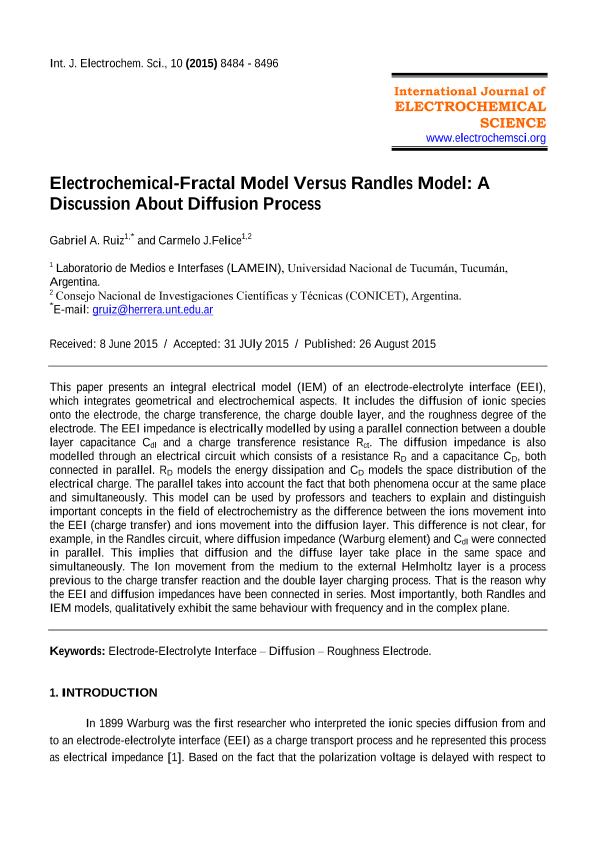Mostrar el registro sencillo del ítem
dc.contributor.author
Ruiz, Gabriel Alfredo

dc.contributor.author
Felice, Carmelo Jose

dc.date.available
2018-06-11T21:04:47Z
dc.date.issued
2015-07
dc.identifier.citation
Ruiz, Gabriel Alfredo; Felice, Carmelo Jose; Electrochemical-fractal model versus randles model: a discussion about diffusion process; Electrochemical Science Group; International Journal of Electrochemical Science; 10; 10; 7-2015; 8484-8496
dc.identifier.issn
1452-3981
dc.identifier.uri
http://hdl.handle.net/11336/48199
dc.description.abstract
This paper presents an integral electrical model (IEM) of an electrode-electrolyte interface (EEI), which integrates geometrical and electrochemical aspects. It includes the diffusion of ionic species onto the electrode, the charge transference, the charge double layer, and the roughness degree of the electrode. The EEI impedance is electrically modelled by using a parallel connection between a double layer capacitance Cdl and a charge transference resistance Rct. The diffusion impedance is also modelled through an electrical circuit which consists of a resistance RD and a capacitance CD, both connected in parallel. RD models the energy dissipation and CD models the space distribution of the electrical charge. The parallel takes into account the fact that both phenomena occur at the same place and simultaneously. This model can be used by professors and teachers to explain and distinguish important concepts in the field of electrochemistry as the difference between the ions movement into the EEI (charge transfer) and ions movement into the diffusion layer. This difference is not clear, for example, in the Randles circuit, where diffusion impedance (Warburg element) and Cdl were connected in parallel. This implies that diffusion and the diffuse layer take place in the same space and simultaneously. The Ion movement from the medium to the external Helmholtz layer is a process previous to the charge transfer reaction and the double layer charging process. That is the reason why the EEI and diffusion impedances have been connected in series. Most importantly, both Randles and IEM models, qualitatively exhibit the same behaviour with frequency and in the complex plane.
dc.format
application/pdf
dc.language.iso
eng
dc.publisher
Electrochemical Science Group

dc.rights
info:eu-repo/semantics/openAccess
dc.rights.uri
https://creativecommons.org/licenses/by/2.5/ar/
dc.subject
Electrode-Electrolyte Interface
dc.subject
Diffusion
dc.subject
Roughness Electrode
dc.subject.classification
Otras Ciencias Químicas

dc.subject.classification
Ciencias Químicas

dc.subject.classification
CIENCIAS NATURALES Y EXACTAS

dc.title
Electrochemical-fractal model versus randles model: a discussion about diffusion process
dc.type
info:eu-repo/semantics/article
dc.type
info:ar-repo/semantics/artículo
dc.type
info:eu-repo/semantics/publishedVersion
dc.date.updated
2018-05-07T18:05:31Z
dc.journal.volume
10
dc.journal.number
10
dc.journal.pagination
8484-8496
dc.journal.pais
Serbia

dc.description.fil
Fil: Ruiz, Gabriel Alfredo. Universidad Nacional de Tucumán. Facultad de Ciencias Exactas y Tecnología. Departamento de Bioingeniería. Laboratorio de Medios e Interfases; Argentina. Consejo Nacional de Investigaciones Científicas y Técnicas; Argentina
dc.description.fil
Fil: Felice, Carmelo Jose. Consejo Nacional de Investigaciones Científicas y Técnicas. Centro Científico Tecnológico Conicet - Tucumán. Instituto Superior de Investigaciones Biológicas. Universidad Nacional de Tucumán. Instituto Superior de Investigaciones Biológicas; Argentina. Universidad Nacional de Tucumán. Facultad de Ciencias Exactas y Tecnología. Departamento de Bioingeniería. Laboratorio de Medios e Interfases; Argentina
dc.journal.title
International Journal of Electrochemical Science

dc.relation.alternativeid
info:eu-repo/semantics/altIdentifier/url/http://www.electrochemsci.org/papers/vol10/101008484.pdf
dc.relation.alternativeid
info:eu-repo/semantics/altIdentifier/url/http://www.electrochemsci.org/list15.htm#issue2
Archivos asociados
